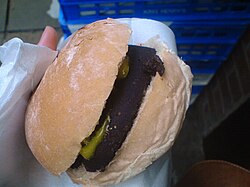 Barm cake with melted butter and black pudding Barm cake with melted butter and black pudding | |
| Type | Bread |
|---|---|
| Place of origin | England |
| Region or state | Historical Lancashire |
| Main ingredients | Barm |
A barm cake is a soft, round, flattish bread item from North West England, traditionally leavened with barm.
Bacon is often the filling for a barm cake, at home or in Lancashire cafes or bakers.
Chips are also a popular filling, sold in most fish and chip shops in the North West of England and often called a chip barm. Another popular filling in the North West, particularly Bolton, is a pasty barm. In Wigan, a whole savoury pie is served in a barm cake, traditionally known locally as a “pie barm” or “slappy”. More recently it is known as a "Wigan kebab", including on the menu of the local football team Wigan Athletic.
See also
References
- John Ayto (18 October 2012). The Diner's Dictionary: Word Origins of Food and Drink. Oxford University Press. p. 21. ISBN 978-0-19-964024-9.
- Angus Stevenson (19 August 2010). Oxford Dictionary of English. Oxford University Press. p. 133. ISBN 978-0-19-957112-3.
- Allied Chambers (1998). The Chambers Dictionary. Allied Publishers. p. 129. ISBN 978-81-86062-25-8.
- Downes, John (28 July 2011). "BBC Food blog: The ale-barm method: Worthy of revival or just barmy bread?". BBC Online. Retrieved 14 June 2019.
...the original method of making yeast bread in Britain was a by-product of ale-making. When traditional ale is made, a yeasty froth appears on top of the fermenting liquid, the wort. This used to be scooped off, washed and added to bread dough in order to leaven it. Bread made this way is sweeter tasting than sourdough, and the leavening yeast used to be called 'barm'. Its unpredictability created the word 'barmy'. In the 19th century, the process was refined and industrialized, manufacturing it on a large scale with what is known today as 'baker's yeast', and used worldwide as the primary method of leavening bread. The barm method appears to be an ancient method developed by Gaelic peoples, and was quite different from that used in Europe, which is to leaven bread with a sourdough or leaven (the French call a similar product 'levain'). When the Romans first conquered Gaul, modern day France, they were astonished by the light sweet bread made by the Celtic inhabitants. Barm bread survived with the Celtic peoples in Britain, Scotland and Ireland, but was not common in Europe, being condemned during the Enlightenment as 'unwholesome'. In England, noblemen's bread, manchet, was always made with the barm method, whereas the commoners' bread, maslin, was a sourdough. Barm bread survived until World War Two, and even later in the North of England, largely as barm cakes. Curiously, the old method of making a sponge, or thick batter of flour and water with the barm was still used with the new industrially produced yeast and was re-introduced to Europe from Vienna where the first yeast factories were established. This became popular in France as a 'poolish', the favoured method of making crusty bread such as a baguette.
- "The bacon barm debate". thefruitytart.org. 28 September 2020.
- "GH Sheldon, Family Bakers, White Barm Cake, Brown Barm Cake". Archived from the original on October 11, 2007.
- "Delicacy is town's favourite snack". The Bolton News. 5 November 2010.
- What is a pie barm? In Wigan, it’s a way of life, The Guardian
- "Foods of England - Wigan Slappy". www.foodsofengland.co.uk. Retrieved 2023-01-26.
- "Match Day Guide For Visiting Supporters" (PDF). Wigan Athletic Football Club.
External links
- Youtube: Making Bread From Barm At Genesee Country Village
- Video on barm bread making in Tudor England - 1475
- BBC Radio 4 Interview - The ale-barm method: Worthy of revival or just barmy bread? Archived 2017-10-28 at the Wayback Machine